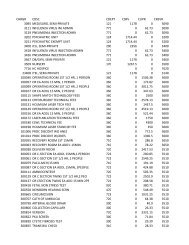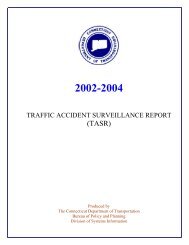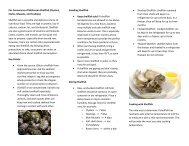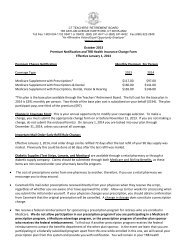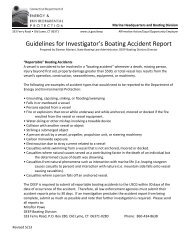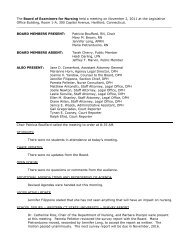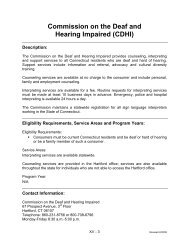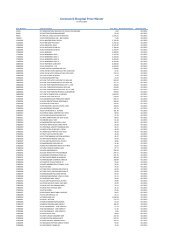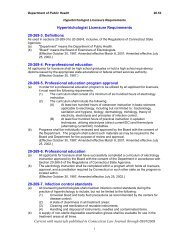Public Act 490 Guide - CT.gov
Public Act 490 Guide - CT.gov
Public Act 490 Guide - CT.gov
Create successful ePaper yourself
Turn your PDF publications into a flip-book with our unique Google optimized e-Paper software.
FREQUENTLY ASKED QUESTIONS REGARDING PA <strong>490</strong><br />
PA<br />
<strong>490</strong><br />
SE<strong>CT</strong>ION 14: FREQUENTLY ASKED QUESTIONS REGARDING PA <strong>490</strong><br />
QWhat is <strong>Public</strong> <strong>Act</strong> <strong>490</strong> and<br />
Use Value Assessment?<br />
A In 1963, the Connecticut Legislature passed PA 63-<br />
<strong>490</strong>, commonly referred to as PA <strong>490</strong>, “An <strong>Act</strong> Concerning<br />
the Taxation and Preservation of Farm, Forest, or Open<br />
Space Land,” (now Section 12-107a-f of the Connecticut<br />
General Statutes). The legislation provided for assessment<br />
of farm, forest and open space land on the basis of its value<br />
as currently used rather than its fair market value at its<br />
highest and best use. “Use value” is the value of the land<br />
when limited to the particular agricultural, forest or open<br />
space use to which it is actually put and not what it might<br />
be worth on the market if sold for some other use such as<br />
residential or commercial development. Every state in<br />
the nation has a Use Value Assessment law for its farm,<br />
forest, or open space land. Each state has different rules<br />
in regards to its particular Use Value Assessment law.<br />
QHow much in property taxes can I save with<br />
<strong>Public</strong> <strong>Act</strong> <strong>490</strong> and how are values determined?<br />
A Each situation is different; however, the savings can<br />
be significant. The Office of Policy and Management (OPM)<br />
in cooperation with the Connecticut Department of Agriculture<br />
is required to develop a recommended schedule of<br />
use values for use by towns for PA <strong>490</strong> land every five years.<br />
Most town assessors use the recommended values rather<br />
than develop the data necessary to establish use values for<br />
each parcel. In nearly all cases these values are significantly<br />
lower than other values such as for residential, commercial<br />
or industrial land. In exchange<br />
for the reduced tax however,<br />
the property owner makes a<br />
commitment not to change<br />
the use of the property for a<br />
period of time. Landowners<br />
should carefully acquaint<br />
themselves with the requirements<br />
imposed upon them<br />
prior to filing.<br />
QDoes my land qualify as farmland<br />
under PA <strong>490</strong>?<br />
A Your assessor makes the determination if your land<br />
qualifies as farmland after you have submitted an application<br />
form. The statutes say an assessor may take into<br />
account, among other things, the acreage, the percentage<br />
of such acreage in actual use for farming or agricultural<br />
operations, the productivity of the land, the gross income<br />
derived from farming and the nature and value of the<br />
equipment used for farming. A frequently asked question<br />
is "How much farmland do I need to qualify?" The state<br />
law sets no minimum. Persons wanting to classify land<br />
under the PA <strong>490</strong> farmland classification must do so by<br />
application to the assessor in the town the land is located<br />
in September or October of each year. The application<br />
must be made on form M-29 Application To The Assessor<br />
for Classification of Land As Farmland. Filing information<br />
accompanies the application.<br />
Q<br />
Does my land qualify for forest land<br />
under PA <strong>490</strong>?<br />
A The minimum acreage for PA <strong>490</strong> Forest Land is set<br />
by statute at 25 acres or more in area bearing tree growth.<br />
This may be (A) one tract of land of 25 acres or more<br />
contiguous acres, which acres may be in contiguous<br />
municipalities (it should be noted that this may be exclusive<br />
of the zoned lot size if a residence is on the parcel); (B) two<br />
or more tracts of land aggregating 25 acres or more in<br />
which no single component tract shall consist of less than<br />
10 acres; or (C) any forested tract of land which is contiguous<br />
to a tract owned by the same owner which has already been<br />
classified as forest land. The application must be made on<br />
form M-39 Application To The Assessor For Classification Of<br />
Land As Forest Land on or before October 1st. A Qualified<br />
Forester’s Report completed by a certified forester must<br />
accompany the application. The local assessor can provide<br />
a list of foresters qualified to complete the report. Filing<br />
information accompanies the application.<br />
30<br />
<strong>Public</strong> <strong>Act</strong> <strong>490</strong>: A Practical <strong>Guide</strong> and Overview • http://www.cfba.org/pa<strong>490</strong>guide.htm • Connecticut Farm Bureau Association




